The Indian Nightjar, a fascinating bird species originating from the Indian subcontinent, is our focus today. I’ve researched and observed these incredible creatures, so let’s dive in and explore together.
With its nocturnal habits and cryptic brown-speckled plumage, it’s no surprise that the Indian Nightjar has an air of mystery.
These birds are masters of camouflage, blending seamlessly into their surroundings during the daylight hours when they’re most vulnerable to predators.
A member of the nightjar family known as Caprimulgidae, this species is primarily found across India, with some populations spilling into Sri Lanka and Myanmar. The habitat range is broad – we can find them in open woodland, scrubland, or cultivated areas.
They hunt for insects in these settings using their excellent night vision and superb flying skills.
Physical Characteristics of the Indian Nightjar
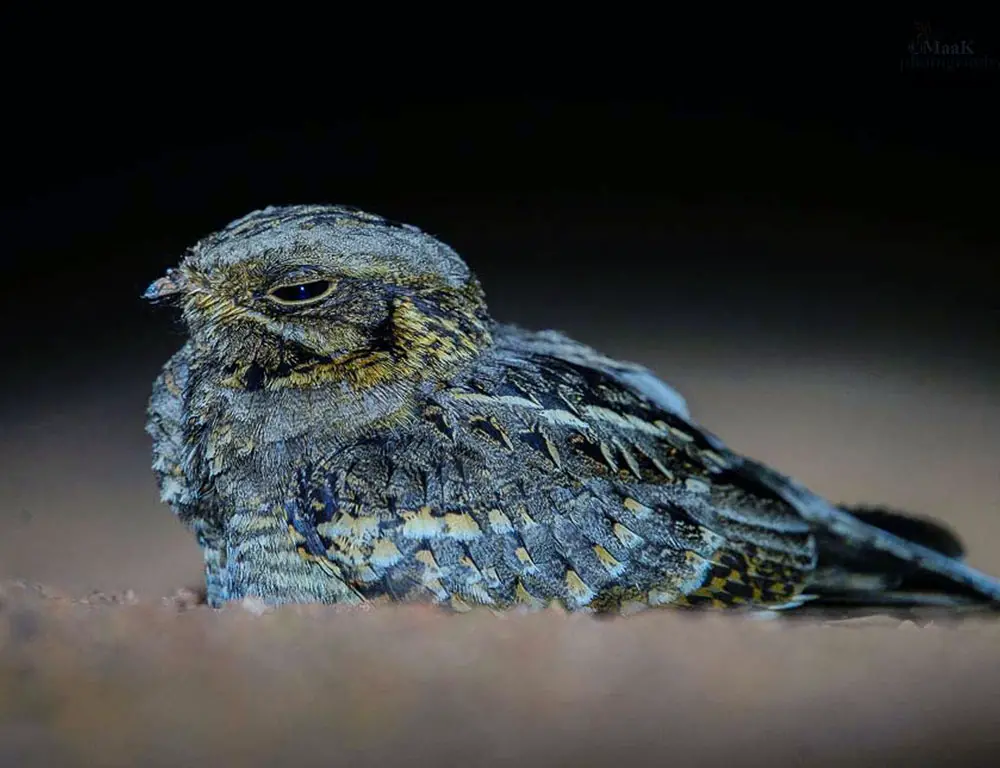
The Indian Nightjar (Caprimulgus asiaticus) possesses physical characteristics finely tuned to its nocturnal lifestyle and habitat preferences.
Here’s a summary of its physical traits:
Camouflage
Their grey and brown plumage provides excellent camouflage, blending seamlessly into their surroundings, especially in open areas with sparse vegetation. This cryptic coloration helps them remain hidden from predators and prey alike.
Size and Wingspan
Adult Indian Nightjars typically measure between 9 to 10 inches in length, with a wingspan ranging from 16 to 18 inches. This size enables them to swiftly navigate the air with precision and silence, crucial for their nocturnal hunting.
Eyesight
Their large, dark eyes grant them exceptional night vision, allowing them to spot prey efficiently, even in low-light conditions. This keen eyesight is essential for their nocturnal hunting behavior.
Legs and Toes
While they have short legs, Indian Nightjars possess surprisingly long toes that aid in ground navigation. These elongated toes assist them in perching and moving across uneven terrain, contributing to their agility on the ground.
Mouth Structure
Indian Nightjars have a wide gape and specialized mouth structure that facilitates their unique feeding behavior. Their short bills and broad mouths, lined with bristle-like feathers, act as effective nets for catching insects mid-flight, allowing them to feed on the wing.
Sexual Dimorphism
One intriguing aspect of Indian Nightjars is the presence of sexual dimorphism. Males exhibit white bands on their outer tail feathers and white patches on each wing, absent in females.
This distinction aids in identifying and distinguishing between male and female individuals.
Habitat and Distribution of the Indian Nightjar
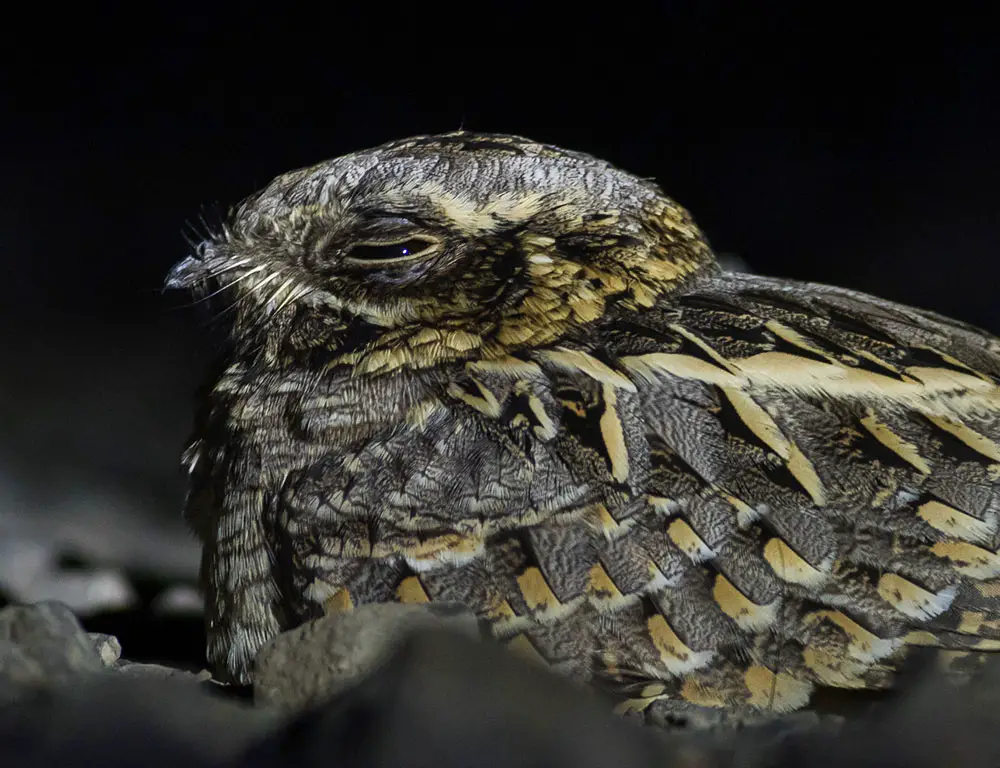
The Indian Nightjar (Caprimulgus asiaticus) is a captivating nocturnal bird with a broad distribution across South Asia. Its habitat preferences and distribution are fascinating subjects, reflecting its remarkable adaptability to various environments.
Habitat Preferences
Indian Nightjars are versatile in their habitat selection, thriving in a range of landscapes, including:
- Grasslands
- Farmlands
- Scrub forests
- Semi-deserts
Additionally, they have shown a remarkable ability to adapt to human-altered environments, often found near human settlements.
Altitudinal Range
While they are typically found at lower altitudes, especially at sea level, Indian Nightjars have been observed up to 1600 meters high in the Himalayan foothills during summer.
The abundance of insects likely influences this elevation preference, their primary food source, at lower altitudes.
Distribution
The distribution of Indian Nightjars spans across several regions:
- South Asia: They are widespread across India (excluding desert regions), Bangladesh, Pakistan, and Sri Lanka.
- South-East Asia: Found in Nepal and down through Myanmar.
- Middle East: Occasional sightings have been reported from Iran.
Population Dynamics
Due to their elusive nature and nocturnal habits, obtaining precise population data is challenging. However, frequent sightings in suitable habitats suggest healthy population numbers.
While they are not migratory, seasonal shifts within their range may occur in response to changes in food availability or weather patterns.
Behavior and Dietary Habits of the Indian Nightjar
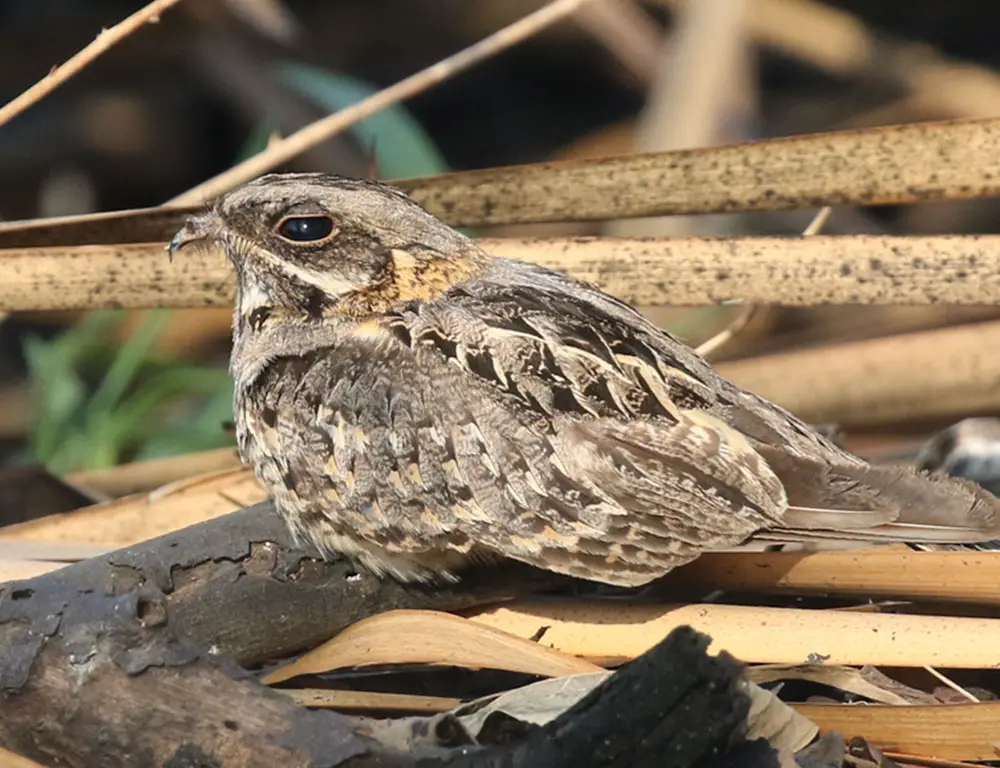
The behavior and dietary preferences of Indian Nightjars offer a fascinating insight into their nocturnal lifestyle and survival strategies:
Nocturnal Behavior
Indian Nightjars are primarily nocturnal, remaining active under the cover of darkness. Their cryptic plumage provides effective camouflage during daytime rest, helping them evade predators.
Feeding Habits
These night flyers predominantly feed on insects, with moths comprising approximately 60% of their diet, beetles at 30%, and other insects making up the remaining 10%. They take flight at dusk to hunt for their prey, showcasing their adeptness at nocturnal hunting.
Mating Rituals
Males engage in elaborate aerial displays to court potential mates, involving high-altitude flights followed by steep dives, creating booming sounds. This intricate mating ritual demonstrates their commitment to reproduction and mate selection.
Nesting Habits
Indian Nightjars exhibit unique nesting habits, preferring flat ground rather than trees or shrubs for nesting sites. They lay their eggs directly on the ground amidst leaves or pebbles, reflecting their close-to-nature nesting strategy.
Reproduction and Life Cycle of the Indian Nightjar
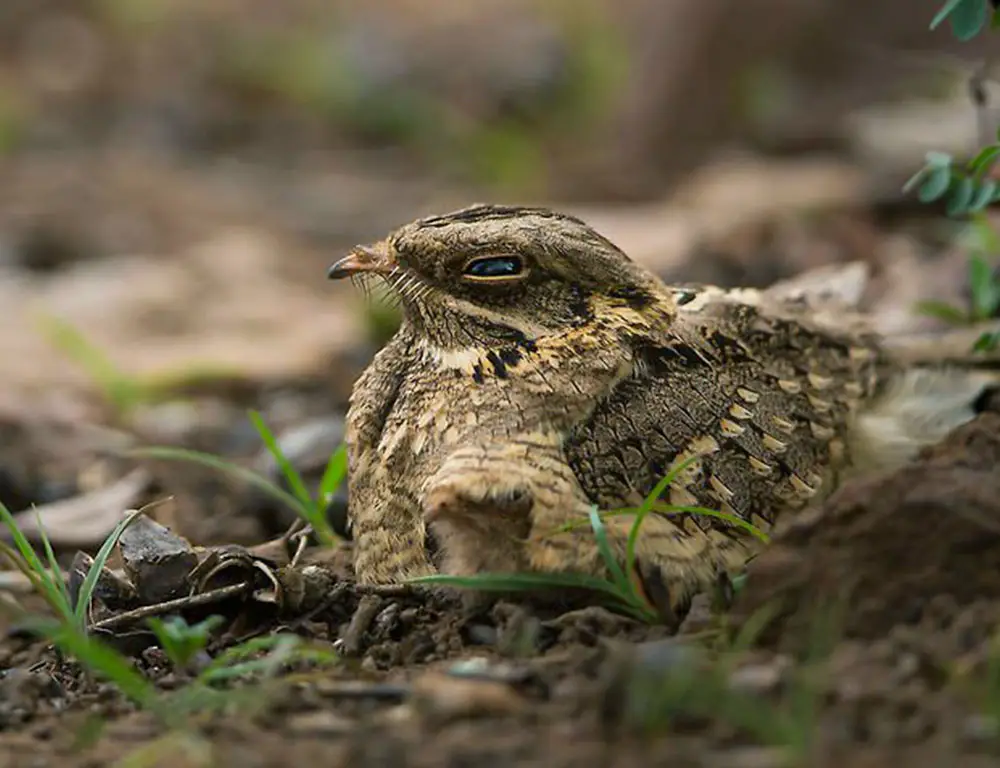
The reproduction and life cycle of the Indian Nightjar presents a captivating narrative of resilience and adaptation:
Mating Season
Indian Nightjars are seasonal breeders, typically mating between March and July. During this period, they engage in courtship displays, with males showcasing elaborate aerial maneuvers to attract females.
Nesting Habits
Unlike many other bird species, Indian Nightjars opt for ground nesting. They lay their eggs directly on open ground, typically producing up to two eggs clutches.
The uniquely patterned shells of the eggs provide effective camouflage, blending seamlessly into the natural surroundings and offering protection against potential predators.
Incubation and Fledging
After an incubation period of around 17 days, the eggs hatch, giving rise to young nightjars. Remarkably, the young chicks swiftly learn to fend for themselves under the guidance of their parents.
The adults diligently feed and care for their offspring until they achieve independence, showcasing the importance of parental care in their life cycle.
Population Trends and Conservation
Despite facing threats such as habitat destruction and human interference, Indian Nightjars have demonstrated remarkable adaptability, maintaining relatively stable population trends, according to BirdLife International.
However, continued conservation efforts are crucial to safeguarding these remarkable creatures and their habitats for future generations.
Lifespan
Adult Indian Nightjars boast an average lifespan of 5-10 years, a testament to their ability to thrive amidst the challenges of the wild. Despite the daily dangers, these resilient birds exemplify survival and resilience in adversity.
Conservation Status of the Indian Nightjar
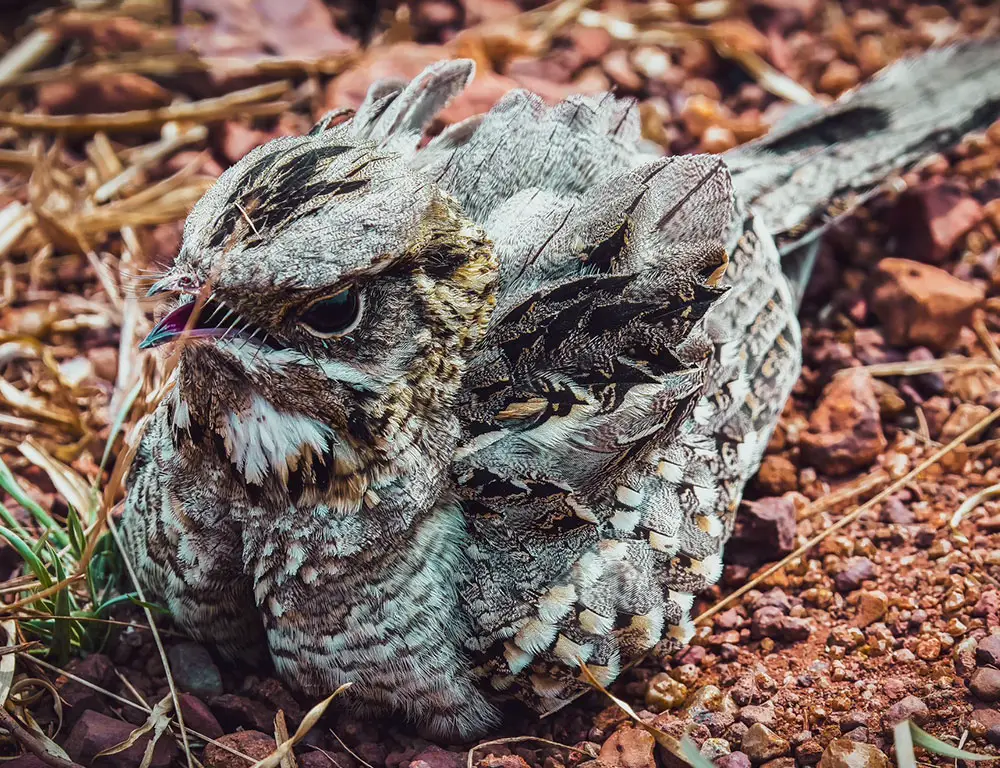
The Indian Nightjar (Caprimulgus asiaticus) is currently classified as “Least Concern” by the International Union for Conservation of Nature (IUCN), owing to its wide distribution and large population size.
However, this designation does not imply that the species is devoid of threats; rather, it underscores the importance of continued monitoring and conservation efforts to ensure its long-term survival.
Primary Threats
- Habitat Destruction: The Indian Nightjar faces significant threats from habitat destruction, mainly due to deforestation and land conversion for agricultural purposes. Given their ground-nesting habits, any disruption to their habitat directly impacts their breeding success and overall population dynamics.
- Pesticide Usage: As insectivorous birds, Indian Nightjars heavily rely on flying insects as their primary food source. The use of pesticides in farming can lead to the contamination of their prey, resulting in either direct poisoning or a decline in available food due to insect population reduction.
Distribution and Population Size
The Indian Nightjar is widely distributed across South Asia, including regions such as India, Bangladesh, Pakistan, Sri Lanka, Nepal, and Myanmar.
While precise population numbers are challenging to ascertain, estimates suggest that the population exceeds 20 million individuals.
Conservation Efforts
Despite its current conservation status, proactive measures are essential to mitigate threats and ensure the continued well-being of the Indian Nightjar population.
Conservation initiatives may include:
- Habitat preservation and restoration projects to safeguard critical nesting and foraging areas.
- Implementation of sustainable agricultural practices to minimize pesticide usage and mitigate habitat fragmentation.
- Community engagement and education programs to raise awareness about the importance of conserving nocturnal avian species and their habitats.
Conclusion
I’ve journeyed through the incredible world of the Indian Nightjar in this blog, and I’m truly amazed by what I have learned. With its intricate patterns and fascinating survival skills, this nocturnal bird has proven to be quite an intriguing subject.
The Indian Nightjar’s camouflage capabilities are exceptional. It can blend perfectly into its environment during the day, making it nearly invisible to predators.
At night, when this bird comes alive with activity, it utilizes its excellent flying ability and keen senses to hunt for insects.
Reflecting on the species’ distribution, it’s clear that the Indian Nightjar thrives in various habitats across South Asia. This versatile creature adapts well to different conditions, from humid forests to arid grasslands.
However, we still don’t know much about these elusive birds. The nocturnal nature of Indian Nightjars makes them difficult subjects for research. But every discovery deepens our understanding not just of their biology but also their role within ecosystems.
Here’s a quick summary:
- The Indian Nightjar possesses effective camouflage that aids in hiding from potential threats.
- Its preferred hunting time is at night, where they consume mainly insects.
- Their habitat ranges broadly across South Asia, including diverse environments like forests and grasslands.
- Research into these creatures remains challenging due to their nocturnal behavior.
In closing my exploration of this topic, I hope you’ve found as much fascination in learning about the Indian Nightjar as I did writing about it. This humble bird epitomizes survival instincts and adaptability – qualities worth admiring indeed!